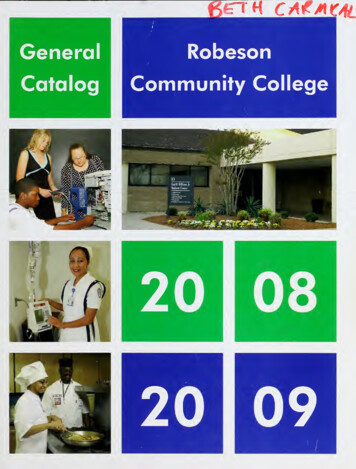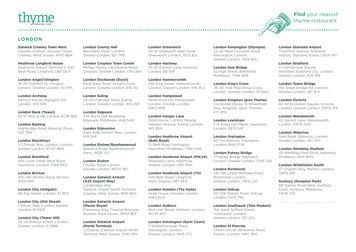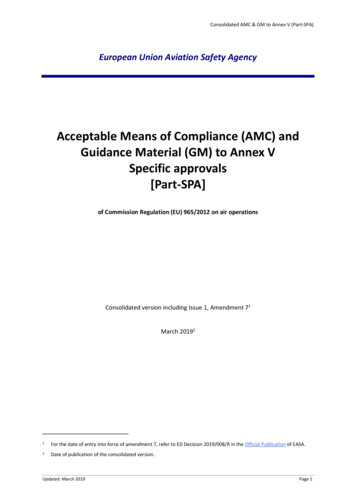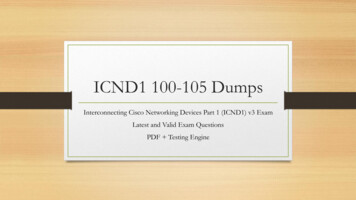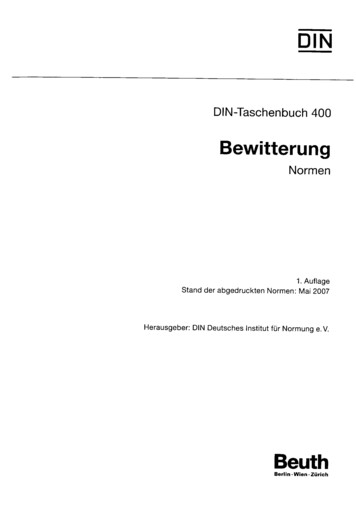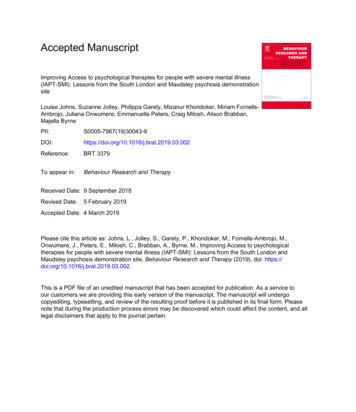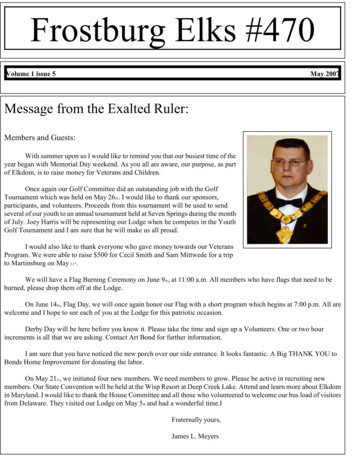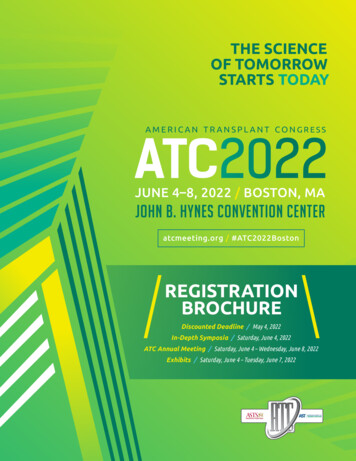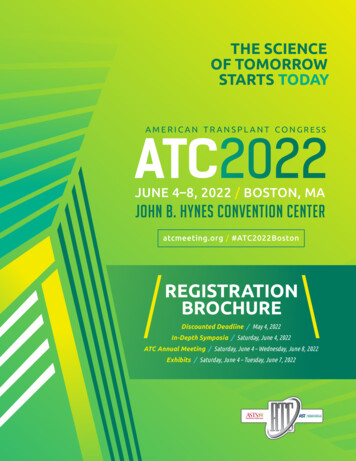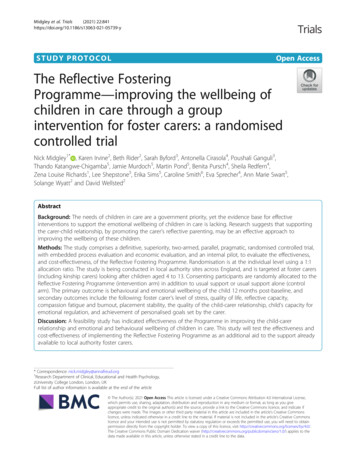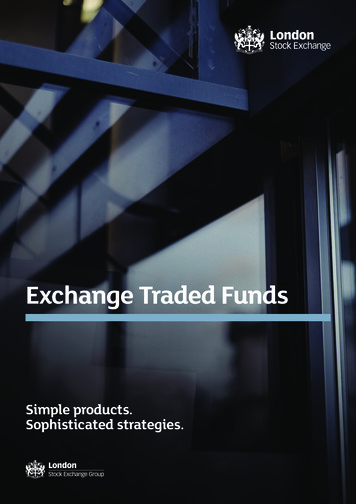
Transcription
ISSUE 105June 2022Voices of theLondon BullionMarket –Chris ElstonTHE BUSINESSCASE FORRESPONSIBLEBUSINESSThe GoldenGuineaand theRoyal Bustpage 4page 12page 22Carbon & the Role of Bankspage 8
Global Precious MetalsConference 20223 30 300 5 Days OrganisationsVenueREGISTER YOURPLACE NOWThe LBMA/LPPM Global Precious Metals Conferenceis taking place in person from Sunday 16 – Tuesday18 October 2022 in Lisbon, Portugal.Register now and look forward to a prestigiousfive-star venue and high-profile speakers. Don’tmiss the many opportunities to network andexpand your business interests, while reconnectingwith others within the precious metals industry,including the LBMA Executive.16 - 18 OCTOBER 2022, LISBON, PORTUGAL
ALCHEMIST ISSUE 105EDITORIALISSUEHIGHLIGHTSMaking ASM More AttractiveBY ALAN MARTIN, HEAD OF RESPONSIBLE SOURCING AT LBMADespite employing an estimated 15million miners and producing between15-20% of the world’s annual goldproduction, less than 1% of ASMmaterial comes through LBMA refiners.These figures suggest that most LBMA refiners have chosen a policy ofavoidance over engagement. This undermines the economic potential ofthe sector, poses a governance threat to refiners, and requires an urgentparadigm shift in how artisanal gold is perceived and refined.INCREASING DIRECT SOURCING OF ASM MATERIALJust how ASM gold can be made more attractive to Good DeliveryList (GDL) refiners was discussed at LBMA’s Sustainability andResponsible Sourcing Summit inMarch. Participants examined aTHE CONTINUEDrange of factors and approachesMARGINALISATIONthat could change currentthinking and ultimately increaseOF ASM MATERIALdirect sourcing of ASM materialHAS SEVERALby our refiners.NEGATIVEWhat can be done to de-risk ASMIMPLICATIONS FORmaterial for LBMA refiners? Is thisTHE GOLD SECTOReven possible? Are due diligenceWRIT LARGEand audit frameworks such as theResponsible Gold Guidance toounrealistic, setting unobtainable expectations and demands? How canbig miners and NGOs help ASM material gain legitimate market accessto LBMA refiners? What are the levers required for NGOs, industry anddevelopment donors to incentivise governments in producing nations tofully appreciate the sector’s potential, and act accordingly?The discussion hinted at some of the ways current thinking couldchange. For example, efforts to ban mercury – one of ASM’s biggestenvironmental risks – should shift from complete elimination toward itsresponsible use and disposal instead. Or ‘progressive due diligence’– a scalable and more accessible process by which ASM material andsuppliers are mentored and integrated into more formal supply chains– could make audit and due diligence frameworks moreattainable to ASM participants.LBMA Chairman Paul Fisher has often called on industryto see mitigation of environmental, social and governancechallenges not as a cost but rather as an investment inthe future. The same argument applies to ASM.EXCLUSION CONSEQUENCESMarket exclusion reinforces the economic and politicalmarginalisation of the sector and its communities,emboldening the indifference by producer countries toformalise miners or implement a supportive legal andregulatory framework within which miners can more safelywork. It also undermines peace and security in high-riskareas by potentially fuelling corruption or funding conflict,thus requiring heightened due diligence requirementsfor businesses.The loss of taxrevenues throughsmuggling furtherundermines theeconomic sovereigntyand the ability ofgovernments to usethose revenues forthe public good,thereby perpetuatingunderdevelopment.Voices of the London Bullion Market– Chris ElstonRecalled by Shelly Ford, page 4Carbon & the Role of Banksby Belinda Ellington, page 8The Business Case for Responsible Businessby Professor Alex Edmans, page 12LBMA Newsby Ruth Crowell, page 15Facing Factsby Federico Gay and Debajit Saha, page 18The Golden Guinea & The Royal BustMost critically, itby Simon Rostron, page 22poses a legitimateCurator’s Cornergovernance issueby Stewart Murray, page 27for the gold industryand end users.Spotlight on GDL AccreditationsASM material stillwith Jinfeng, page 29gets into legitimateRegulation Updateglobal markets viaby Graham Jelf, page 30trading centres withlax due diligenceFront cover – A gold mine's head gearrequirements. There,silhouetted against the evening skyline.it gets relabelled asGraeme Williams/Panos Picturesrecycled material,masking its originsand bypassing any semblance of due diligence. None of this is in theinterests of the gold industry.STEPS TO PROGRESSMiners, refiners and end users all have a self-interested role to play.The first step is to reimagine the sector as a business opportunity,rather than as a tokenistic stab at CSR.Secondly, industry actors must commit to long-term and sincereengagement with the sector by demonstrating an appetite for riskmitigation, rather than avoidance, and working through any sourcingissues an ASM partner may encounter. Doing so would help overcomethe mistrust many ASM actors have toward the formal gold sector.Thirdly, it requires a broad acceptance that, for durable change tocome, the challenges facing the ASM sector are fundamentally ones ofunderdevelopment. And for this reason, foreign donors should providesustained, multi-year funding to projects aimed atfixing the foundational challenges facing the sector.WITH THE SECTORACCOUNTING FORAS MUCH AS 20% OFANNUAL PRODUCTIONTHE FIRST STEPIS TO REIMAGINETHE SECTORAS A BUSINESSOPPORTUNITY RATHERTHAN A TOKENISTICSTAB AT CSRAs we move forward on this renewed engagementwith the ASM sector, we are guided by the adviceof one Summit participant: “Focus on makingprogress, not perfection.”So stay tuned! We will share updates at the LBMA/LPPM Global Precious Metals Conference 2022, inLisbon, in October.Alan manages LBMA’s Responsible Sourcing Programme for precious metals, which is mandatory for all Good Delivery ListRefiners. Prior to joining LBMA, Alan spent over a decade carrying out investigative research into the intersection between naturalresources, human rights and illicit financial flows. As the former director of research at IMPACT, he has an intimate understandingof the challenges and vulnerabilities to responsible sourcing in the artisanal mining sector, trading and refining hubs, and jewellerymanufacturing centres. Born and raised in Southern Africa, he holds a Master’s degree in conflict and development from the Schoolof Oriental and African Studies (SOAS) at the University of London.3
ALCHEMIST ISSUE 105VOICES OFTHE LONDONBULLIONMARKETChrisElstonRECALLED BY SHELLY FORDChris Elston, Bank of England rooftop.Eagled-eyed readers may spot thebuilding now home to LBMA just behindChris, at 62 Threadneedle Street.Chris Elston was born in Harrow,Greater London, in 1938 to parentsHerbert and Ada. After his primaryand secondary education in Harrowand Hampstead respectively,Chris studied at Kings College,Cambridge, where he undertook aClassics degree. From the cobbledstreets of Cambridge, Chris joined theBank of England.BANK OF ENGLANDChris’ Classics degree wasn’t an awful lot ofuse to the Bank, he concedes, except that theBank liked generalists in those days. Whenit eventually came to the view that actually, itwould like some economists, there weren’t manyalready in situ in the early 1960s.4The Voices of the London BullionMarket project brilliantly capturesand contextualises the changes anddevelopment of the bullion marketthrough the eyes of those who workedin it. So far in the series, we havefeatured the voices of 12 people fromthe market. In this latest feature, wereflect on Chris Elston’s career in thebullion market, taken from a recordedconversation with Michele Blagg in 2014.And rather than recruiting already qualified economists, the Bankthought “oh well, we’ll train our own” – so it sent Chris off to Yale fora year to do a Master’s degree in Economics, which he accepted withalacrity.Chris’ time at Yale turned out to be exceedingly useful for him, despitebeing very hard work. Indeed, Chris describes it as a great experiencewhich made his career in the Bank of England different from whatit might otherwise have been. His time at Yale paved the way forhis secondment to the Bank for International Settlements in Basel,Switzerland, in its Monetary and Economics Department – a role leftvacant by Eddie George, who, of course, went on to become Governorof the Bank of England.George was a hard act to follow, but after two years there, Chrisreturned to the UK and into the Economic Section of the Bank ofEngland – which was a very small team in 1971, withprobably no more than 20 people at the most.CHRIS’ TIME ATYALE TURNEDOUT TO BEEXCEEDINGLYUSEFUL FOR HIMDESPITE BEINGVERY HARD WORKChris admits that he wasn’t very at home there, nothaving worked before on the UK economy and thereforebeing unfamiliar with the sources. A disadvantageof the year of economics at Yale was that it requiredmore mathematics than Chris had, as he’d stopped thesubject at school after O level without touching calculus.
ALCHEMIST ISSUE 105So, he was duly sent to the OverseasDepartment at the Bank to do a moregenerally-based economics role in theInternational Studies Group. This pulledtogether the economic work of all thedifferent territorial groups in the overseasdepartment, and was a role in which Chrisflourished. This led to two other roles asPrivate Secretary to the Governor and in theChief Cashier’s Department as Assistantto the Chief Cashier, largely concerned withthe mechanics of issuing and redeeminggilt-edged stocks. From there, he moved toJapan, on loan to the Diplomatic Service asFinancial Attaché at the Tokyo Embassy, foran initial three-year tenure.Chris found this role fascinating, and abrilliant insight into the workings of what hewould call two very ‘Byzantine Institutions’– the Japanese economy and the BritishForeign Office – both of which were new tohim and very different from what he’d beenused to at the Bank of England.When Chris returned to the Bank after avery enjoyable four years in Tokyo, he wasappointed Adviser and later Senior Adviserin what by then was called the InternationalDivision, with responsibilities as the eyesand ears of the Bank covering the whole ofAsia, from Pakistan to New Zealand.After some 12 years in this role, theInternational Division was disbandedand Chris could have taken slightly earlyretirement at the age of 57.But instead, his friend and colleague TerrySmeeton, sadly now deceased, had heardthat Alan Baker, then Chairman of LBMA, waslooking to appoint a Chief Executive to runthe Association and suggested that Chrisshould get in touch with him.Chris Elston in the Lake District, 1974.Kings College, Cambridge.CHRIS MEETS ALAN BAKERVEIL OF CONFIDENTIALITYAt their first meeting, Chris told Alan: “Look,I’ve had 35 years in the Bank of England.I know virtually nothing about the bullionmarket. I’ve had little or no contact with it.But I’m willing to learn.” No doubt Chris’experience demonstrated his capabilities,and after an interview with LBMA’sManagement Committee, Chris got the jobas LBMA’s first Chief Executive in 1995 on athree-day-a-week contract.Chris received what he thought was a slightlymixed reception from some LBMA memberswhen he joined. Some didn’t seem tookeen to spend much time telling this guyfrom the Bank of England what they weredoing, and why. There was a fair amount ofconfidentiality and secrecy in the marketat that time, and Chris guesses there stillis to some degree. This confidentiality wasdemonstrated perfectly by the fact that forthe first one or two biennial dinners thatLBMA hosted during Chris’ time as ChiefExecutive, it was deemed inappropriateto include a guest list with the eventinformation, as it would give away whichclient guests belonged to which memberhosts. Member client lists were closelyguarded. Chris thought that was ratheroverdone, but that’s how it was to begin with.Now, he believes client guests’ names areincluded as standard and he’s relieved thatthis veil of secrecy, as he saw it,has been at least partly lifted.When Chris arrived at LBMA, the firstAlchemist was in preparation under theeditorship of Jeffrey Rhodes of StandardBank, and Chris concentrated on improvingand easing the administrative work relatedto servicing the various Committees anddealing with queries.As the work and his responsibilitiesincreased, Chris negotiated a four-daya-week contract and was working withStella Thompson as secretary. Overtime, Chris says, he got to knowthe market pretty well. Always oneto underplay his achievements,he believes that he didn’t becomeanywhere near an expert in goldtrading, but he did “get to knowwhat it’s all about”.NoChris spent around five yearsat LBMA. During this time, hewelcomed a full-time editor ofthe Alchemist (Suzanne Capanofrom Commerzbank), and theAssociation grew from its oneroomed residence in FredericksPlace, which was rented fromthe London Investment BankersAssociation and accommodateda grand total of three desks.LBMA has grown somewhatsince these humble beginnings.In retrospect, this desire forconfidentiality from a minority ofplayers may well have hinderedChris from fully immersing himselfin certain quartersdoubt Chris’of the market. Thatexperiencesaid, all those ondemonstrated his committees – includingthe Managementcapabilities, andCommittee – wereafter an interview always very helpful.with LBMA’sManagementCommittee, Chrisgot the job asLBMA’s first ChiefExecutive in 1995on a three-day-aweek contract.For example, Chrisspent a day with MartinStokes at J.P. Morgan,who showed him whatit was like being amarket trader. AlthoughChris didn’t understandmuch of it, he got auseful feel for it. AlanBaker was alwaysextremely forthcoming and helpful, as wereother subsequent Chairmen – as well as thefirst Chairman, Robert Guy of Rothschild.5
ALCHEMIST ISSUE 105COMMITTEES: ENHANCINGTHE BULLION MARKETChris sat in on all committee meetings:the Physical Committee, FinanceCommittee, Public Affairs Committee and,of course, the Management Committee.While he administered the agendas, theminutes and the discussions, he notedand admired the extent to which seniorfigures were able and willing to take timeout from their own institutions to run thecommittees. They did a greatjob, and it must have been quiteAT ONE SUCH EVENT,difficult. They no doubt all raisedWHICH WAS SPONSOREDtheir profile in their respectiveinstitutions, but it was goodBY LBMA, A BIT OFvoluntary work which benefitedAN ‘ARGY BARGY’a) the bullion market and b)OCCURREDDUE TO THELondon, as a financial centre asFINANCIALTIMES NOTa whole – of which the bullionALLOWING LBMA TOmarket was an important butnot a major part in terms of thePLACE THE ALCHEMISTvolume of trading, compared withON DELEGATES’ SEATS.the foreign exchange marketand the bond market.But nevertheless, it was the major bullionmarket in the world and the committeemembers did their bit to keep it going andenhance it.'Star Player'.CONFERENCE BEGINNINGSAlthough Chris’ role as Chief Executivewas mainly based from the London office –such as it was – he did go to the FinancialTimes World Gold Conference.At one such event, a bit of an ‘argy bargy’occurred due to the Financial Times notallowing LBMA to place the Alchemist ondelegates’ seats. The FT was happy forLBMA to provide a lot of the audience, andmany speakers, but it would not allow LBMAliterature on seats.Probus visit to Chiswick Brewery, February 2012.6While frustrating at the time, this clashsowed the seed for LBMA to run its ownConference. Stewart Murray had come onboard as Chief Executive in succession toChris in 1994/95, from Goldfield’s MineralServices, and had introduced the AssociateMember classification, which had begun tobring in more money and which offered theimpetus, and means, to increase LBMA’sprofile. Somebody thought up the slogan‘The Conference for the Industry, by theIndustry,’ and that’s what it was all about.LBMA’s own Conference took off, thanks toStewart and all those who didthe work on it.interests of UK financial institutions, as wellas interpreting and reporting, would all beuseful skills and experience essential intaking the LBMA forward.”Reflecting on what’s changed in the marketsince his stewardship, Chris says thatLondon has remained the centre for thevolume of trading, both spot and forward,and for new and different typesof bullion market instruments.Whether the numbersby which London exceededother markets has narrowedor not, he’s not sure.SOMEBODY THOUGHT But, of course, themain thing that holdsUP THE SLOGANit together is the‘THE CONFERENCEGood Delivery List.The inaugural LBMAPrecious MetalsConference, held inthe year 2000, hostedFOR THE INDUSTRY,some 277 delegates.There has also beenBY THE INDUSTRY,’Now, the Conferencea gradual increase inAND THAT’S WHAT ITregularly pulls in morenon-Market Makingthan 650 delegatesWAS ALL ABOUTMembers and,from around the world,certainly, an increasebringing together high-profilein those who want their names on the Goodspeakers and representativesDelivery List. This set of standards has,from across the preciousrightly, become de facto, is trusted aroundmetals industry.the world, and has made LBMA’s namesynonymous with leadership and qualityCommunicating and networkingwithin the precious metals industry.always helps when it comes tosuccess, according to Chris.Chris served as Chief Executive fromIndeed, that’s exactly what1995 to 2000.Alan Baker wrote in the firstAlchemist: “Mixing economicand financial market expertise,establishing close professionaland personal relationships,leading discussions with awide range of interests andnationalities, assessing policyand interests and promoting
At Dillon Gage, we never rest on our success.We continually upgrade and refine. Giving you the best possible serviceand giving the rest of the industry NEW standards to strive for.TRADING - REFINING - STORAGE - TECHNOLOGY - FULFILLMENTWe do it all and we do it best with the FizTradeTM suite of apps and products:FizTrade Mobile - IRAConnect - FizRefinery - IDS Client Portal - DGGoldDillon Gage - moving the industry into the future.DILLONGAGE.COM800.375.4653
ALCHEMIST ISSUE 105CARBON& THEROLE OFBANKSBY BELINDA ELLINGTON, MD, GENERAL COUNSEL, GLOBAL COMMODITIES, ESG, CITIGROUP GLOBAL MARKETSThis is an updated version of Belinda’skeynote speech at the LBMA Sustainabilityand Responsible Sourcing Summit inLondon, 28-29 March 2022.INTRODUCTIONWhen I was preparing to give this speech oncarbon and the role of banks, I was remindedof one of my daughters when she was aboutfive years old who, in a state of existential rage,shouted at me: “What’s the point of you?”Now that she’s considerably older and a little bitwiser, she realises the benefit of the parental bankand the competitive interest rates she gets frommeeting her KPIs. My relationship with my daughterhas changed to meet her needs and, likewise, sohas banking over the last six years or so.8I want to look at how banks look differently at their investments andservices in the light of environmental, social and governance (ESG)responsibilities, which have changed incredibly rapidly.When I first sought out people involved with ESG at Citi, probablyabout six years ago, I was kindly directed towards a group of wellmeaning people who were picking up litter at the weekend,and I said: “No, no, no, this isn’t what I’m talking about.Whichever driverThere’s a tsunami of legislation and obligations which areyou’re looking atgoing to hit us.”we’re all movingtowards the samedestination wherewe must measureand account forthe impact of theclimate on us –AND OUR IMPACTON THE CLIMATEDUAL LENSWell, I’m pleased to say that like most large financialinstitutions, Citi has now warmly embraced the challengesof responding to climate change, and we’ve got a very wellset-up infrastructure, including climate risk committees,that look at the risks and responsibilities of the bank –and products specifically designed to meet client ESGrelated needs.
ALCHEMIST ISSUE 105We look at everythingnow through a ‘duallens’ – considering theimpact of the bank onthe climate, and theclimate on the bank.This means we look atall areas of investmentand determine whetheran investment has anadditional risk due toclimate change. For abank that additional riskmay then be translatedinto conventional marketrisk and credit risk.Ultimately, banks area service industry. Wehave clients at our core,and we are lookingto help those clientsachieve their own ESGgoals, including theirtransition to net zero.Belinda sat next to John Mulligan, Director of Market Relations and Climate Change Lead at the World Gold Council,at the Sustainability & Responsible Sourcing Summit. The Summit was jointly hosted by LBMA and the World GoldCouncil in March 2022.LITIGATION RISKSo, what are the drivers for moving towardsWe can neatly package climate risks,net zero? I think, first of all there’s what youtranslating them into market risk and creditmust do – adhering to compliance regimes,risk, but I also want to cast an eye towardsfor example where you are required tolitigation risk. There’s a litigation risk websitemeasure and disclose climate impact orcalled Climate Case Chart. It’s worth havingyour carbon footprint. Then there’s what youra look at. If you are a potential polluter, itcustomers and your investors would likewould be alarming. If you’re an environmentalyou to do. This implies a voluntary element,campaigner, well, it’s tubbut really it’s a Hobson’sthumpingly triumphant. TheWHATEVER YOURchoice. And then there’snumber of litigation caseswhat you do because ofVIEW ON THEhas just exponentially grown.your own motivation tomake a change.SCIENCE ITAPPEARS THATALL CORPORATESWILL NEED TOTRANSITION INORDER TO SURVIVELooking through your owndual lens, it’s necessaryto consider not only yourown compliance obligationsand stakeholder pressure,but you’ve got to consideryour entire value chain and think about theobligations and pressures on them, and thenlook back and see how that might impactyour own organisation.Take, for example, the shipping, airfreight,energy production, cement and steelindustries in the EU. These are all going tobe affected by legislation intended to limittheir emissions and force them to pay for anyresidual emissions through the purchase ofcarbon allowances or offsets and/ or payingcarbon border taxes. That will impose anaddition cost on a carbon footprint. Who isgoing to absorb that increased cost? Myprediction is that it will be carried alongthe chain from source to consumption.Effectively, the price of carbon will be addedto everything that we consume.The point is that whichever driver you’relooking at, we’re all moving towards thesame destination where we must measureand account for the impact of the climateon us – and our impact on the climate – andthen adapt. Anybody not on that journey risksbeing stranded.Secondly, you need the political willpower.Changing social values can change policiesat government and at corporate level, but attimes I think policies need to change first –and this is one of those times.And thirdly, of course, you need the money.Enter the banks. Let’s think about whatbanks do. Banks do exactly the same as theyalways did, but with an added ESG benefit.There are ESG-linked derivatives, greenbonds that issue a ‘greenium’, repo financingof green-starred securities, and green loans.They are the same financial solutions as theywere before, but now they can be linked togenuine, measurable and verifiable KPIs ofthe transition to Net Zero.At the moment, it tends tobe focused on the fossil fuelindustry. So, leaving asidesimple failure to complycases brought by regulatorsThat the KPIs are genuine, measurable andand other governing bodies,verifiable is crucial, because the shadow ofI think these cases fall intolitigation for greenwashing looms, and thethree ‘buckets’. The first bucket containsimpact can be serious. In addition, genuineclaims of deception, misrepresentationKPIs are critical for the sustained integrity ofor, a word we all probably know now,ESG-linked financing.Greenwashing. Then there are those seekingto attach responsibility for the past, presentCARBON MARKETSand also future impact on the environment.Turning to carbon markets; briefly, theAs the science gets better, the chain ofdifference between compliance and thecausation gets shorter. In the third bucketvoluntary markets. Compliance marketsare claims seeking to stop certain activitiesaffect those sectors that have a regulatoryor to force people to comply with the Parisobligation to offset their carbon footprint.Agreement and reduce their emissions.Offsets tend to be issued or authorised byWhatever your view on theGovernments andscience, or your motivation, Wherever you have influenceare sometimesto me it appears allcalled permits toyoumustengagetoensureorganisations will need topollute or carbontransition towards net zerothere’s a workableallowances. Anin order to survive.organisation, forlegal frameworkexample in theSo what does ‘transition’built around ESGenergy sectormean? Firstly, we need theobligations andin the EU, musttech and the engineering,account for theirwhich many would arguethe carbon marketscarbon footprintis already here. We haveandsubmitcarbonallowancesequal to thatcarbon capture and sequestration, we havefootprint. The number of allowances issuedrenewable energy, and hydrogen fuel cells.into the sector is capped at the target forThe issue is that this is all very expensive.the sectoral carbon footprint and partiesBut as the price of carbon increases and themay trade those allowances, so they areprice of polluting increases, the price of thecommonly called ‘Cap and Trade’ systems.tech becomes more attractive.The EU ETS is an example.9
ALCHEMIST ISSUE 105In contrast, voluntary market participants have no regulatoryENGAGE AND COLLABORATE WITH LEGISLATORSobligation to offset, but this is a growing market. Offsets tend toSo what needs to be done? First of all, I think legislators need tobe project based issued by certain Standards like Verra or thecollaborate, but it’s also essential that we engage and collaborateGold Standard. A party may register a project with a Standard,with those legislators. Wherever you have influence, you mustdemonstrating they intend to implement a methodology that willengage to ensure there’s a workable legal framework builtremove or reduce carbon emissions. When thearound ESG obligations and the carbon markets. And whenLET’S SEE THIS AS I say the carbon markets, I also mean your obligation toproject owner submits independent verificationthat those emissions have in fact been removedAN OPPORTUNITY disclose and report your own carbon account.or reduced, the Standard will issue carbon creditsTO DELIVERWe need common standards for sustainability disclosuresequal to such removal or reduction. These carbonWHATSOCIETYand carbon accounting, that is counting the carbon andcredits can then be sold for voluntary offsetting.IS DEMANDINGaccounting for it. And we need common taxonomies. What isA key difference is in some compliance markets“sustainable”? What is a “reduction”? What is “material”?like the EU ETS, project-based carbon credits areWe need participants within industry sectors to collaborate, andnot eligible for use. It is easy to see that the purchase of the carbonthat’s what we’ve got at this Sustainability and Responsible Sourcingcredits funds the project and encourages financial flows to areasSummit. In one room we’ve got an entire industry sector, and industrywhere reductions and removals can be made.sectors can drive change.What banks do within both of those markets is what they do in allmarkets. They provide financing (for carbon credit projects, thatHOMEWORK SHARINGmight be by way of prepaid offtake agreements that provide theAnother issue is that no one wants to be out front. Where do younecessary seed funding); they intermediate between buyers andposition yourself? You may be cautious to self-impose higher standardsellers, providing liquidity and market access; and they alsothan everybody else, because it could put you at a disadvantage. But,provide price risk management.likewise, so could falling behind the pack.I did wonder whether, for example, a goldmine that was transitioningWhat is clear is at the moment is that no one entity has the answers,to reduce its carbon emissions could register itself as a viable carbonso all could benefit from some homework sharing – being open onreduction project. Certainly, in the Clean Development Mechanismhow to achieve your transitions to Net Zero.(CDM), there was the methodology for coal mining to register itself asa viable carbon reduction project. Maybe something for this audienceWith all the uncertainty, I think we have to see this as an opportunity. Ourto explore.planet will survive, but our lifestyle might well become unsustainable.Let’s see this as an opportunity to deliver what society is demanding.Let’s see disclosure as an opportunity to show how you’re transitioningto attract the right kind of investment. And let’s set genuine paths toBelow: Opening Session at the Sustainability & Responsible Sourcing SummitNet Zero with solid, measurable KPIs along the way, so you can takein March 2022. On the panel with Belinda are Randy Smallwood, World Goldadvantage of all that green-coloured money. Or you could just wait andCouncil Chairman, Paul Fisher, LBMA Chairman and John Mulligan, Director ofsee what happens, with your fingers crossed. If you do not spend onMarket Relations and Climate Change Lead at the World Gold Council, andmitigation and adaption, I think you risk becoming a fossil yourself.Ruth Crowell, LBMA Chief Executive Officer (not pictured).Belinda is MD and General Counsel at Citi, based in London. Her roles include leading the GlobalCommodities legal team, and providing legal support for ESG in Global Markets and the Citi Climate Risk Committee.B
ALCHEMIST ISSUE 105. Chris Elston was born in Harrow, Greater London, in 1938 to parents Herbert and Ada. After his primary and secondary education in Harrow and Hampstead respectively, Chris studied at Kings College, Cambridge, where he undertook a Classics degree. From the cobbled
